- Colston Loveland can be an immediate top-12 fantasy tight end: While Loveland’s volume stats aren’t elite, his per-play metrics match up to other great young tight ends of recent seasons.
- Bhayshul Tuten went from a zero-star recruit to NFL prospect: Tuten started his college career in the FCS and worked his way to becoming a fourth-round pick in the NFL draft.
- Subscribe to PFF+: Get access to player grades, PFF Premium Stats, fantasy football rankings, all of the PFF fantasy draft research tools and more!
Estimated reading time: 10 minutes

Rookies are highly sought after in fantasy football drafts because of their risk. While there is a chance they won’t work out in their first season, there is also a chance they will become an instant star.
Picking the right rookie can greatly increase your chances of winning a fantasy championship. Most rookies are getting selected at an appropriate spot, but some rookies are being drafted in the 10th round or later and have the potential to be steals, given their talent and situation.
The average draft position listed is from a consensus between ESPN, Sleeper and Yahoo! for where the player is picked on average in a 12-team, redraft league.
Last updated: Tuesday, July 15
TE Colston Loveland, Chicago Bears (ADP: 11.04)
Loveland became the Wolverines’ second tight end behind Luke Schoonmaker in 2022, running nearly as many routes as the current Dallas Cowboy. In 2023, current Seattle Seahawk AJ Barner transferred to Michigan. Barner was the better blocker, but Loveland emerged as the better receiver. Loveland missed some time early and late in the 2024 season but remained Michigan’s top receiving option at the position with even better per-game and per-play numbers.
Michigan‘s run-heavy offense limited Loveland’s routes. The Wolverines often had a significant lead by the fourth quarter, which limited Loveland’s playing time in those games. From a situational perspective, he was nearly perfect in every way except crossing routes. He also didn’t perform well in contested catch situations.
Loveland’s 88.5 receiving grade over the last five seasons ranks eighth-best among Power-Five tight ends, behind Brock Bowers, Dalton Kincaid, Charlie Kolar, Michael Mayer, Tyler Warren, Maliq Carr and Sam LaPorta. At least part of the reason he’s lower is volume, as his 2.22 yards per route run is fourth-best and better than fellow potential first-round tight end Tyler Warren. Loveland’s separation rate was in the 96th percentile among tight ends over the last two seasons. He has the talent to be a top-12 fantasy tight end as a rookie.
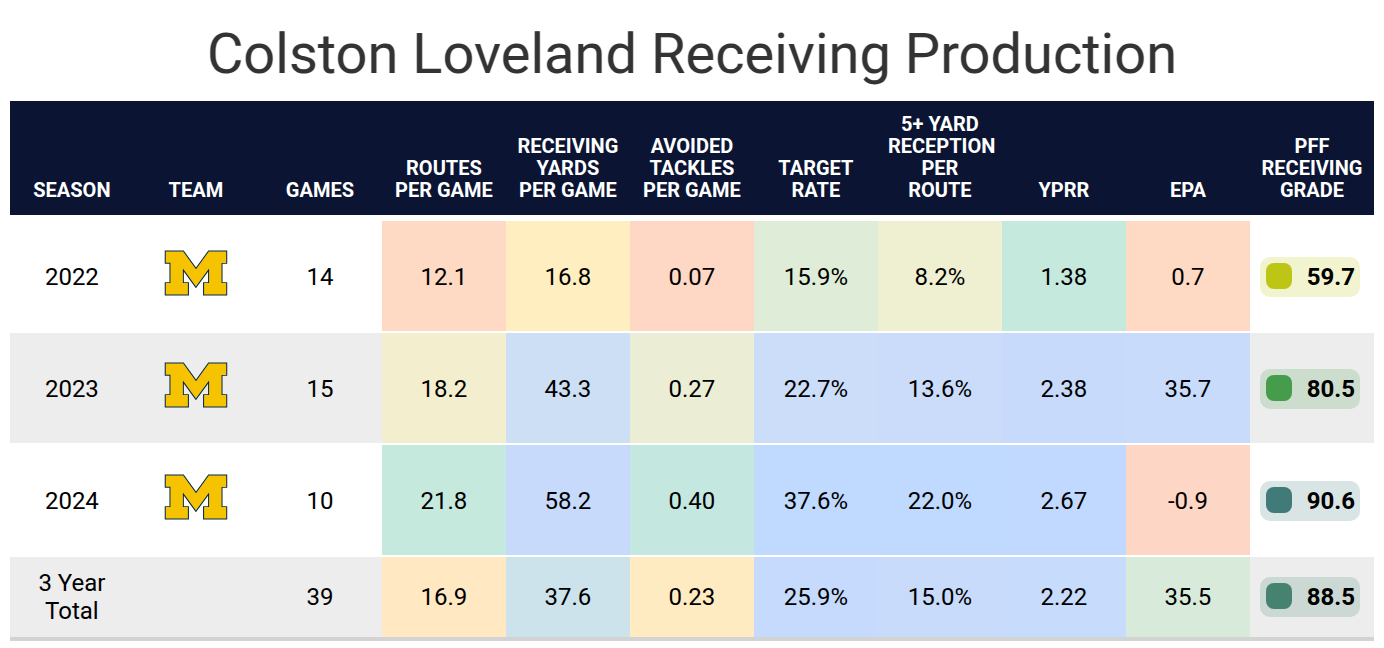
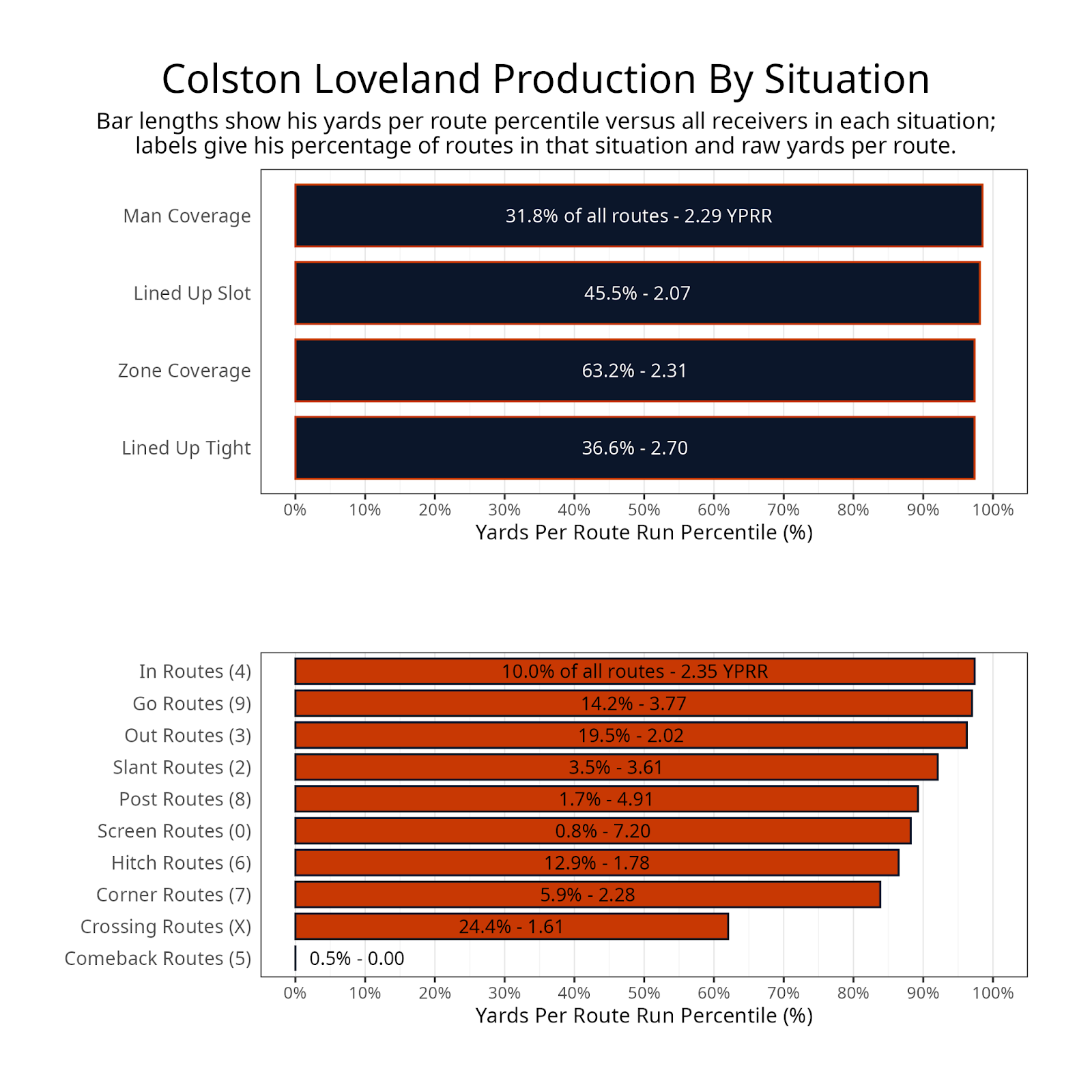
Ben Johnson is the new Chicago Bears head coach, and a big reason to be optimistic about Loveland. In Detroit, he had Sam LaPorta, who has a 53.2 run-blocking grade over the last two seasons. That didn’t stop Johnson from playing LaPorta consistently in 11 and 12 personnel, only taking him off the field consistently in 21 personnel. This is likely the path Johnson will also take with Loveland. Chicago doesn’t have a true fullback on the roster, but there will likely be some clear run situations where Kmet and Durham Smythe are on the field instead of Loveland, but this hasn’t been a problem for players like LaPorta or T.J. Hockenson.
Johnson also typically runs a lot of plays and has a high points-per-game total. All optimism on the offense hinges on Caleb Williams’ development. Williams had three games this season with an offensive grade above 80.0 but ended the season with a passing grade below 60.0 in five of his final six games. The former first overall pick has an entirely re-worked offensive line and multiple new receivers to throw to, so he’s being given every opportunity to succeed. Williams’ willingness to throw deep targets more than most quarterbacks could lead to some big plays by Loveland. LaPorta led all tight ends in deep receiving yards last season, so Johnson knows how to draw up deep shots to the tight end position.
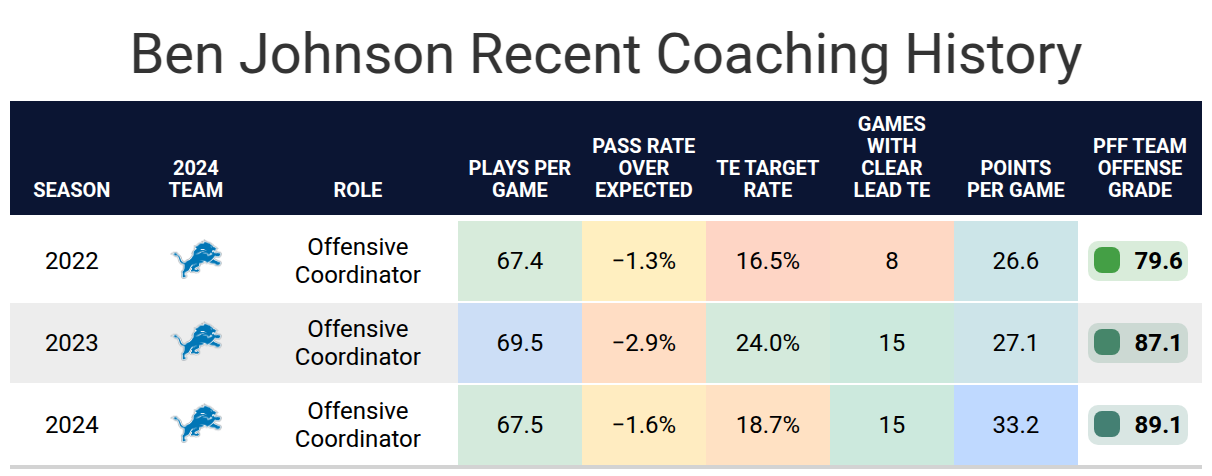
Loveland has all of the makings of the next elite fantasy tight end. Ben Johnson’s offense needs to work out, and Caleb Williams needs to take a step forward for Loveland to get there. Still, it’s reasonable to be optimistic about Loveland’s production as a rookie.
RB Bhayshul Tuten, Jacksonville Jaguars (ADP: 13.05)
Bhayshul Tuten earned high grades during his first two collegiate years at North Carolina A&T before transferring to Virginia Tech. He has been the Hokies’ lead running back in the last two seasons, although he has shared duties on third downs.
Tuten’s 86.7 career FBS rushing grade is the second-lowest among the top-11 consensus running backs, but he arguably had the least help from his offensive line. His 1.6 yards before contact per attempt were tied for the lowest among those 11 running backs. That likely hurt his ability to gain first downs, but he, at least, partially made up for it with his big-play ability. While Tuten posted a blazing-fast 4.32-second 40-yard dash at the combine, his top speeds based on PFF’s tracking data have been merely average for a prospective NFL running back.
Tuten joins a complicated Jacksonville Jaguars backfield, making it even more perplexing. Last season, the Jaguars utilized a three-back committee with Travis Etienne Jr., Tank Bigsby and D’Ernest Johnson. The team opted not to re-sign Johnson, and a new coaching staff means the rotation from last season isn’t very helpful in determining what will happen this season.
Etienne started his career, looking like a great runner with an 83.2 PFF run grade. His run grade has steadily declined (62.8 last season). Bigsby was the better runner, but his role in the passing game has been non-existent. Before Tuten’s arrival, it seemed like Bigsby could be Jacksonville’s early-down back while Etienne is the passing-down back. Etienne dealt with injuries last season, which potentially impacted his grades. This meant there was a chance of Etienne regaining his early-down role.
Tuten was a feature back at Virginia Tech, dominating snaps, particularly in short-yardage situations, and only playing roughly half of the third-down snaps. This suggests Tuten is more of a threat to Bigsby’s snaps. From a measurable standpoint, Tuten stands out from the other two backs, ranking in the 88th percentile or better in the 40-yard dash, 10-yard split, bench press, vertical jump, broad jump and 20-yard shuttle. New head coach Liam Coen was the offensive coordinator of the Tampa Bay Buccaneers, where Rachaad White was similarly athletic but as a bigger back. White was primarily a receiving back. The fact that Tuten was picked by the new regime and the others weren’t worked in his favor, but being a fourth-round pick works against him.
Until we have more clarity on how snaps will be distributed between the three running backs, drafting any of them is a gamble.
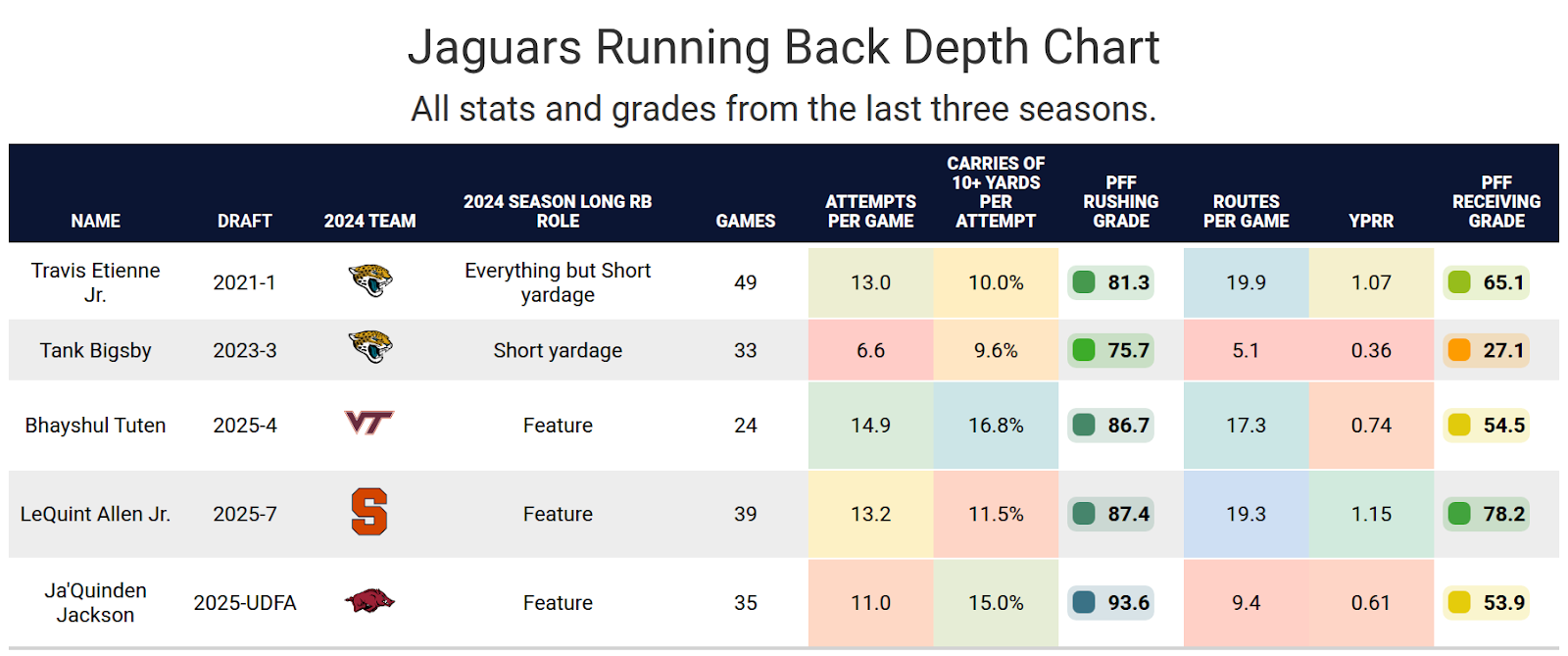
Tuten will have Liam Coen as his new offensive coordinator. There weren’t many similarities between his offense with the Los Angeles Rams and his offense with the Buccaneers. At the very least, Coen showed a willingness to get a fourth-round pick involved with Bucky Irving last season. While Irving and Tuten are the same height and were fourth-round picks, there are also plenty of differences between the two backs.
Tuten should be viewed more favorably than most handcuff running backs. Like all handcuffs, there is a chance he won’t hold any fantasy value this upcoming season, but there is also a path for significant playing time if he can simply outperform the other running backs on the roster.
RB Jaydon Blue, Dallas Cowboys (ADP: 13.02)
Jaydon Blue spent his three seasons at Texas as a backup running back. In 2022, he was behind Bijan Robinson, Roschon Johnson, Keilan Robinson and Jonathon Brooks, who all made their way to the NFL. He reached starter status to begin the 2024 season, but in Week 7, he ran 11 times for 34 yards while Quintrevion Wisner ran 13 times for 114 yards, leading to Wisner taking over for the rest of the season. Blue continued to play significant snaps despite being the backup.
Where he stood out in 2024 was as a receiver. He ran 15 routes per game, but was targeted on over one-fourth of his routes, which is exceptionally high for a college running back. Understandably, all of his cumulative and rate stats were similarly high. His receiving grade wasn’t very high, primarily due to five dropped passes and a fumble. He was a clear top receiving back from the draft class when eliminating all negatively graded plays by receivers.
Blue is an undersized running back at 5-foot-9 and 196 pounds, but a fast one. His 4.38-second 40-yard dash time is among the best from a running back, and his PFF tracking data backs that up.
Blue lands with the Dallas Cowboys with a completely new backfield for 2025. They moved on from Rico Dowdle, Ezekiel Elliott and Dalvin Cook, and added veterans Javonte Williams and Miles Sanders and drafted Blue and Mafah.
This should be a wide-open competition. Williams has the most recent experience as a runner. He received double-digit carries in six games in the first nine weeks, but then his role was toned down. Sanders has graded better as a runner, but that was largely from his 2022 season with the Philadelphia Eagles. During his two seasons with the Carolina Panthers, he averaged 3.5 yards per carry. Phil Mafah had both more experience and graded better as a runner among the two college players, but Blue was drafted earlier. Any one of these four players could lead the team in rushing, and it shouldn’t be a surprise.
On passing downs, the competition is likely between Williams and Blue, considering Sanders and Mafah’s grades on passing downs and low yards per route run.
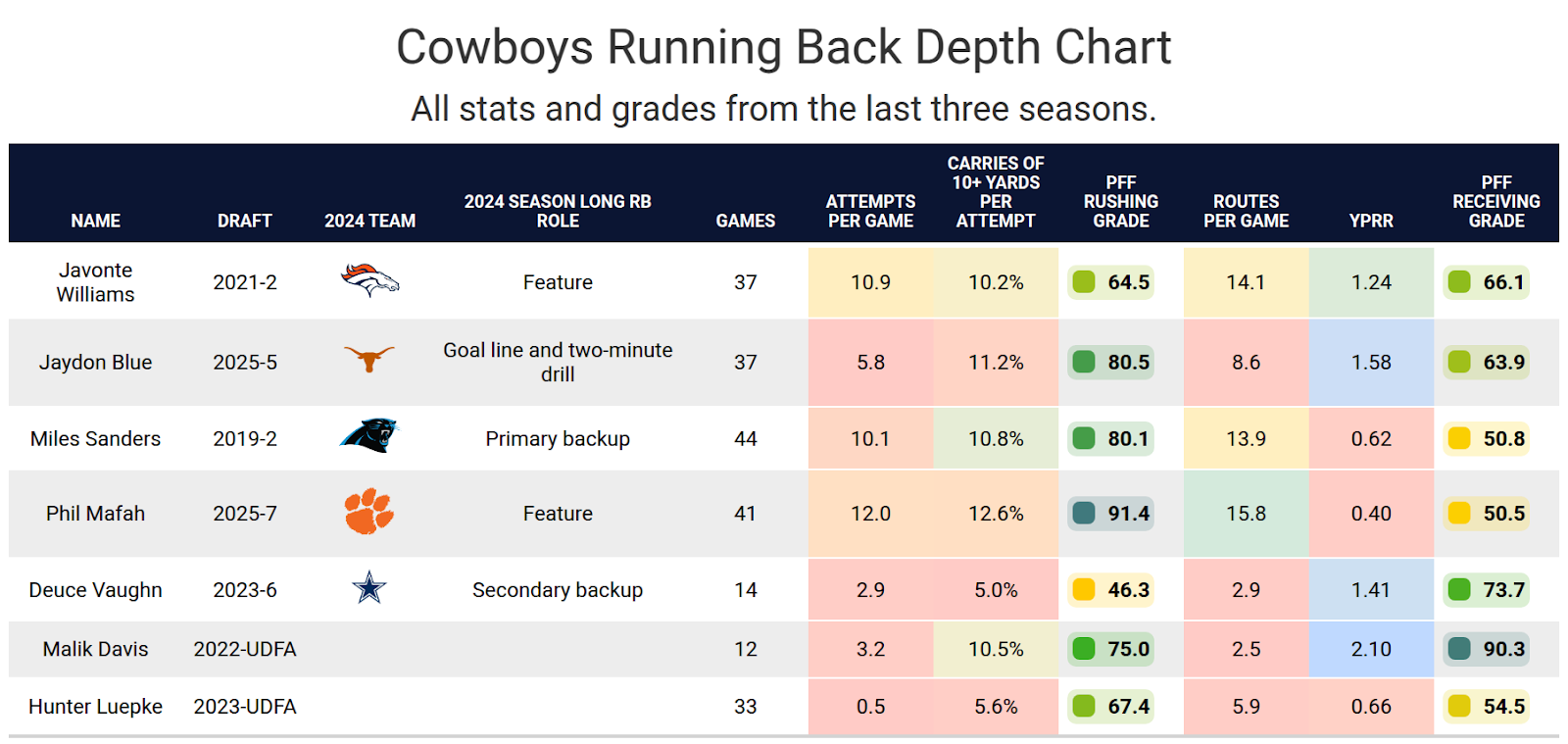
The Cowboys have invested heavily in their offensive line after Tyron Smith‘s departure last offseason and Zack Martin‘s retirement this offseason. Veterans Tyler Smith and Terence Steele have become players to build around. Tyler Guyton and Cooper Beebe had mixed results as rookies, while Tyler Booker was the third first-round pick in four years. The line was ultimately below average last season, but it has sky-high potential if the younger players can live up to the draft capital invested in them.
Blue is a relatively inexperienced running back entering a wide-open competition for the Cowboys’ backfield. Blue may be a full-time starter at some point this season, but it’s also possible he ends up fourth on the depth chart. At this point, all of the Dallas running backs are nothing more than late-round dart throws.
WR Emeka Egbuka, Tampa Bay Buccaneers (ADP: 12.03)
Egbuka spent the past three seasons as the second option in Ohio State’s passing game, first behind Marvin Harrison Jr. and then behind Jeremiah Smith. The Buckeyes were often ahead in games, allowing them to run the ball with future NFL running backs. That hurt Egbuka’s cumulative statistics, but his per-route numbers are very strong relative to other wide receivers. His target rates remained extremely high for a No. 2 receiver.
Egbuka checks many boxes, including high separation scores and catch rates. While his speed isn’t elite, it’s what you would expect from a mid-to-late first-round pick of his size. On the downside, the PFF Draft Guide notes his “route breaks could be sharper” and “his breaks aren’t as sharp or twitchy as some.”
In general, you hope to see college players improve each season, but that wasn’t the case for Egbuka. He played so well in his second year that there wasn’t as much room to put up bigger numbers, but he also never exceeded an 85.0 PFF receiving grade in a season — a mark that most potential first-round wide receivers reach.
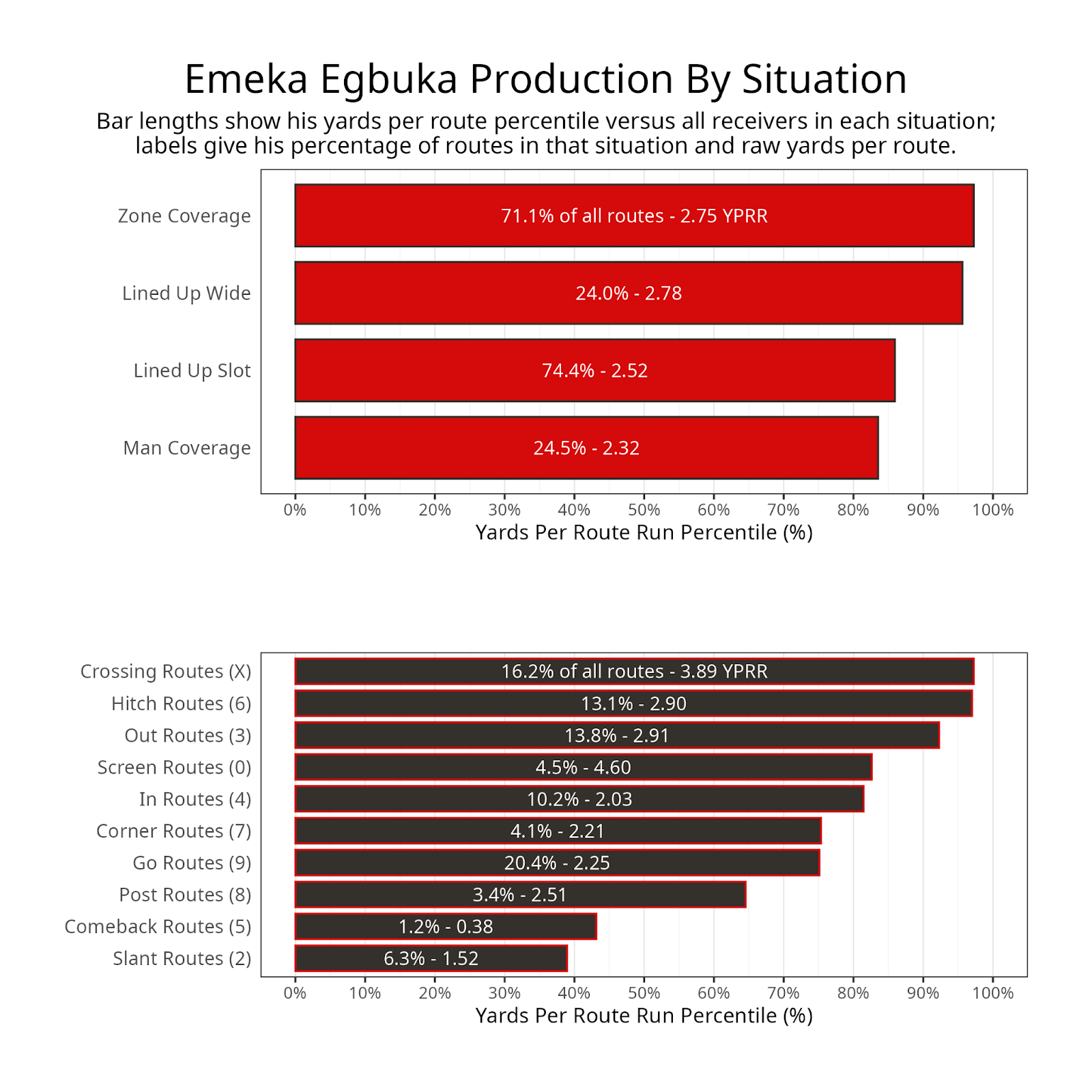
Egbuka is projected to be a slot receiver, as he played nearly 75% of his snaps there in college, but he could also play the Z role.
If you ranked the teams that needed a wide receiver the most heading into the draft, the Buccaneers would be near the bottom of the list. They retained future Hall of Famer Mike Evans, re-signed Chris Godwin and watched as 2024 third-round pick Jalen McMillan shone late in his rookie campaign. For Egbuka to play significant snaps in his most natural role as a rookie, he would need to beat out Godwin — one of the most prolific slot receivers of the past decade and a top wide receiver in fantasy points per game last season.
Egbuka’s clearest path to playing time is by beating out McMillan for the Z receiver role. McMillan similarly played in the slot in college and moved out wide with Tampa Bay. Even if Egbuka wins the Z receiver job, there aren’t enough targets to go around. McMillan had a 14.8% target rate last season, which isn’t strong enough to be a fantasy starter. During the six games where Evans and Godwin were both fully healthy last year, all of the other receivers combined averaged just over four targets per game.
If no one in Tampa Bay is injured, it’s hard to imagine Egbuka becoming a fantasy starter in the near future. Even if Evans retires after the season, Godwin, McMillan and Egbuka are all better suited to be slot receivers or Z receivers rather than X receivers, making it challenging for the three to coexist. Both Godwin and McMillan will be on the roster for a minimum of two seasons.

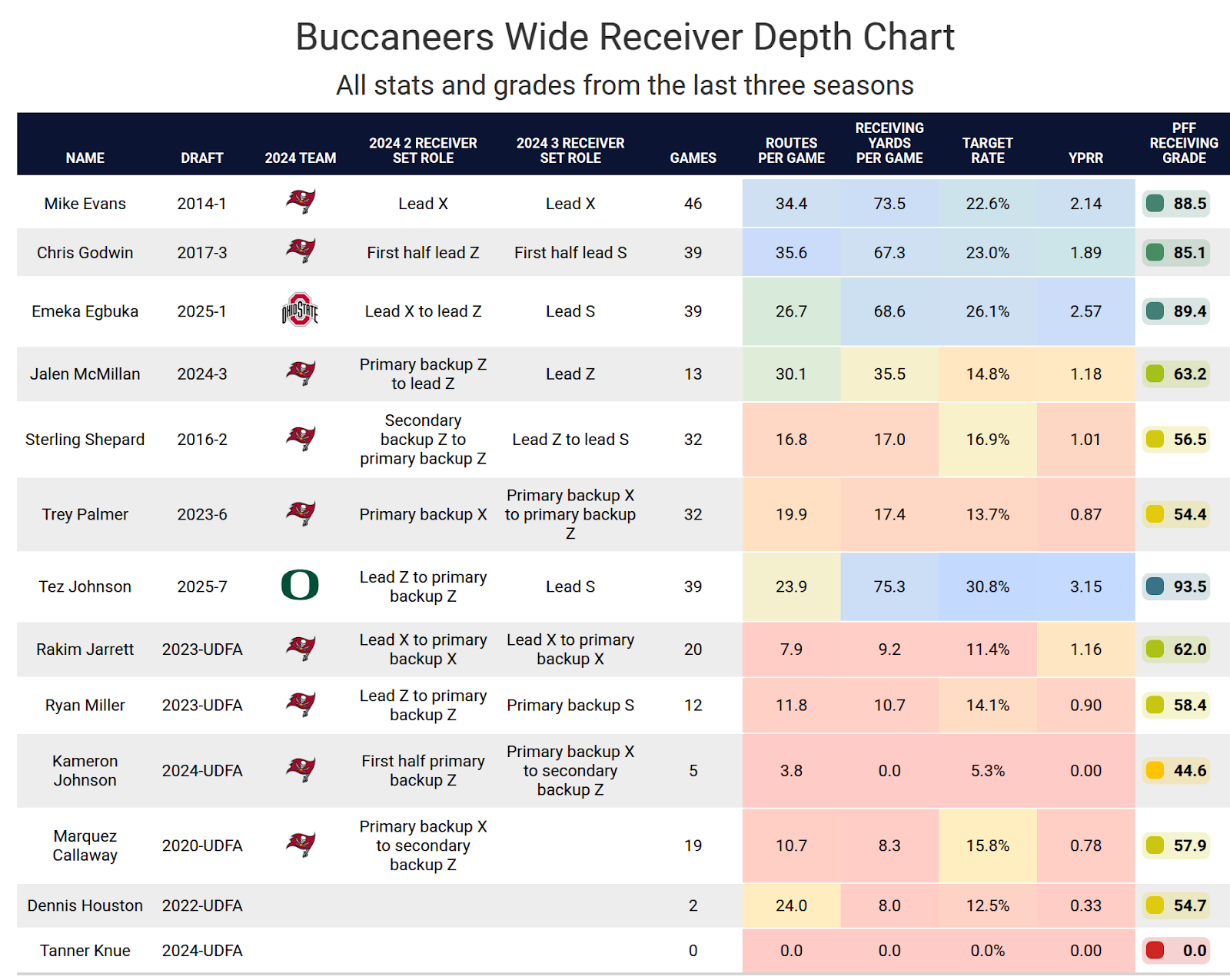
Egbuka is a very talented rookie, but he was consistently the second wide receiver in Ohio State’s offense. With the Buccaneers, he will likely be the third option in the short term — although he still carries sleeper potential because of his opportunity to beat out McMillan.
WR Luther Burden III, Chicago Bears (ADP: 13.04)
Burden was one of Missouri‘s top two wide receivers for the past three seasons. In 2023, he earned the third-highest PFF receiving grade among Power-Five receivers, behind Malik Nabers and Malik Washington but ahead of Marvin Harrison Jr. and Rome Odunze. That included a top-five yards-per-route-run figure that ranked just ahead of Ladd McConkey.
Burden’s 2024 numbers weren’t nearly as strong due to injuries and Missouri‘s offensive decline. The Tigers’ offense ran the second-most running plays in the SEC during the regular season and logged a below-average number of passing plays. That limited Burden’s routes relative to some other receivers. On a per-play basis, he remained relatively strong. His separation rate over the past two years was the best among the top five receivers in the class. The PFF Draft Guide focused on his well-rounded skill set, his ability to play every position and his biggest weakness being his blocking ability.
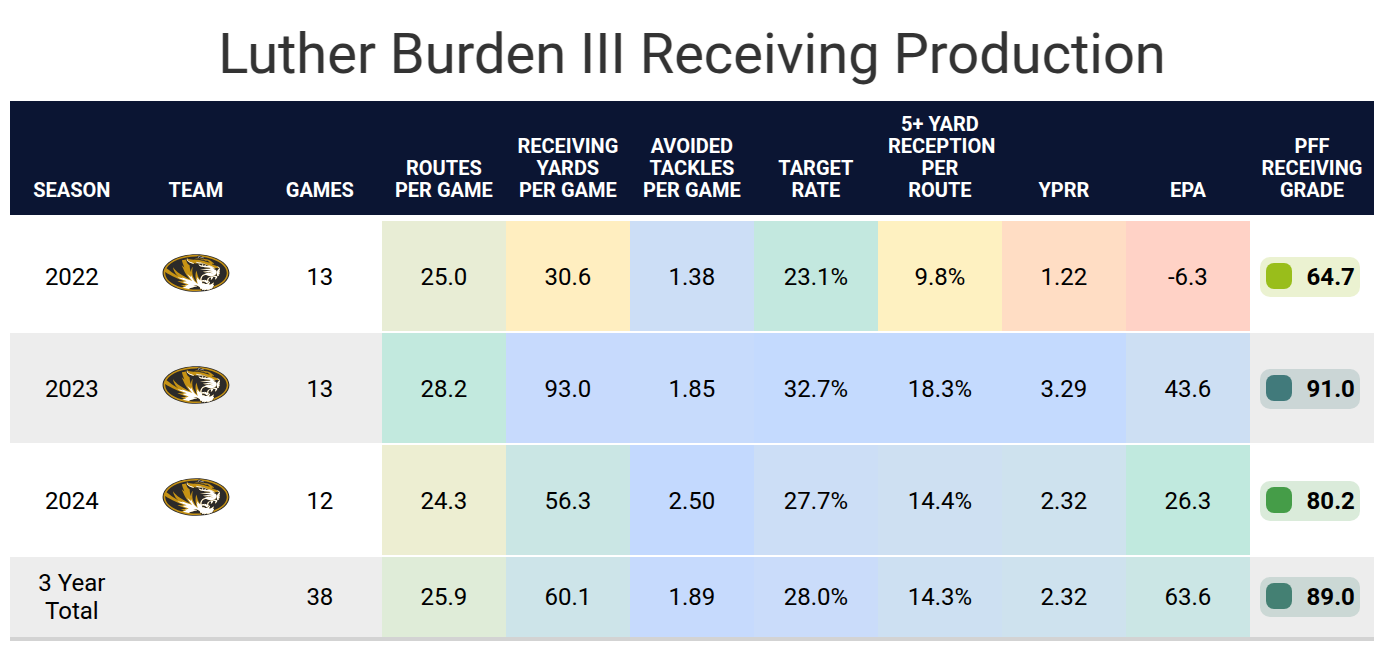
Burden spent his college career primarily playing out of the slot as a low-average-target-depth receiver. He joins a Chicago Bears team with D.J. Moore and Rome Odunze, who have spent most of their careers on the outside. Odunze played 33% of his snaps from the slot last season, while Moore has never logged more than 31% of his snaps from the slot. The Bears made two free-agent additions who have primarily played out of the slot in Olamide Zaccheaus and Devin Duvernay. Still, both were signed to low-risk one-year contracts, and Burden should surpass them on the depth chart relatively quickly.
It is difficult to trust a wide receiver, for fantasy purposes, if they are playing in the slot only. For example, Khalil Shakir was the Buffalo Bills‘ best receiver last season, catching passes from the league MVP. He mostly played in three-receiver sets and finished 37th in fantasy points per game. Burden would need to beat out Odunze, who was a top-10 pick but underperformed as a rookie and was drafted by the past regime.
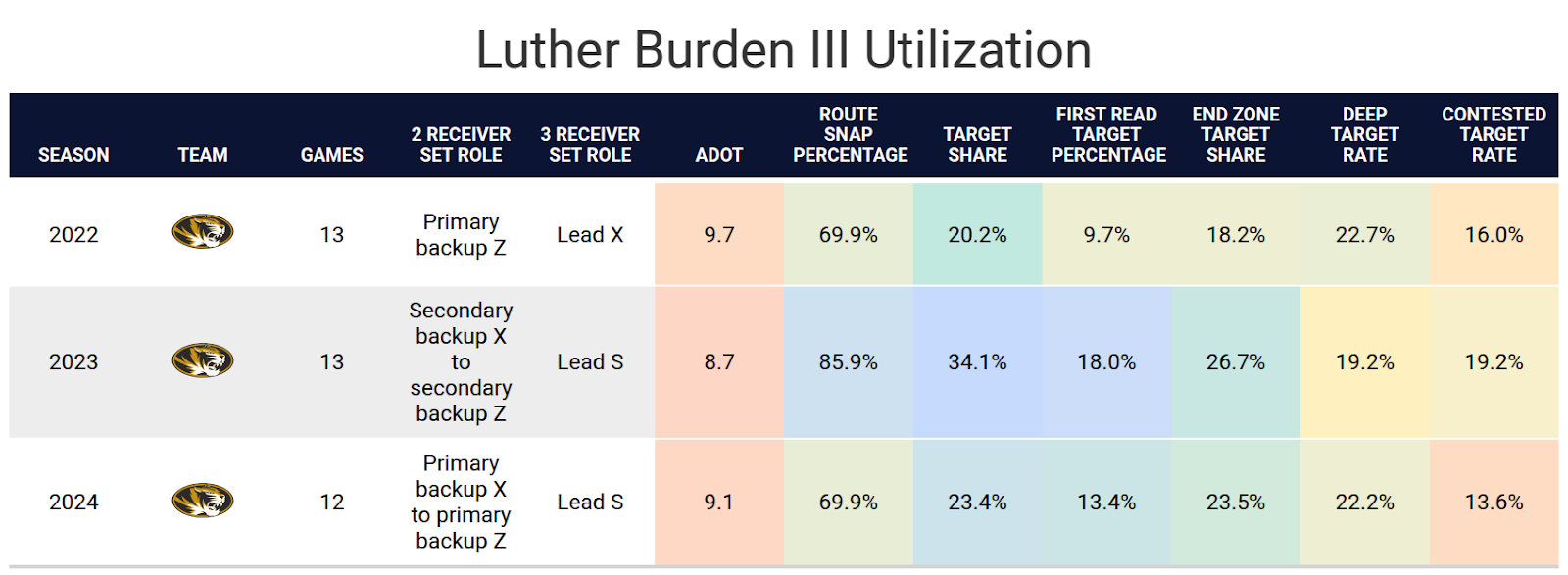
Optimism abounds about the Bears’ passing game because of new head coach Ben Johnson, whose offenses run a lot of plays and score a lot of points. Slot receiver Amon-Ra St. Brown was the focal point of his passing game with the Lions, and Burden is the most likely receiver to fill that role in Chicago. However, St. Brown was also playing consistently in two-receiver sets, and Johnson’s offenses stayed in two-receiver sets more often than most teams.
Caleb Williams’ development is key. Williams had three games this past season with a PFF overall grade above 80.0 but ended the season with five sub-60.0 marks in his final six games. The 2024 first-overall pick has an entirely reworked offensive line and multiple new receivers to throw to, so he’s being given every opportunity to succeed. Burden won’t become fantasy-relevant as a rookie unless Williams takes a step forward.
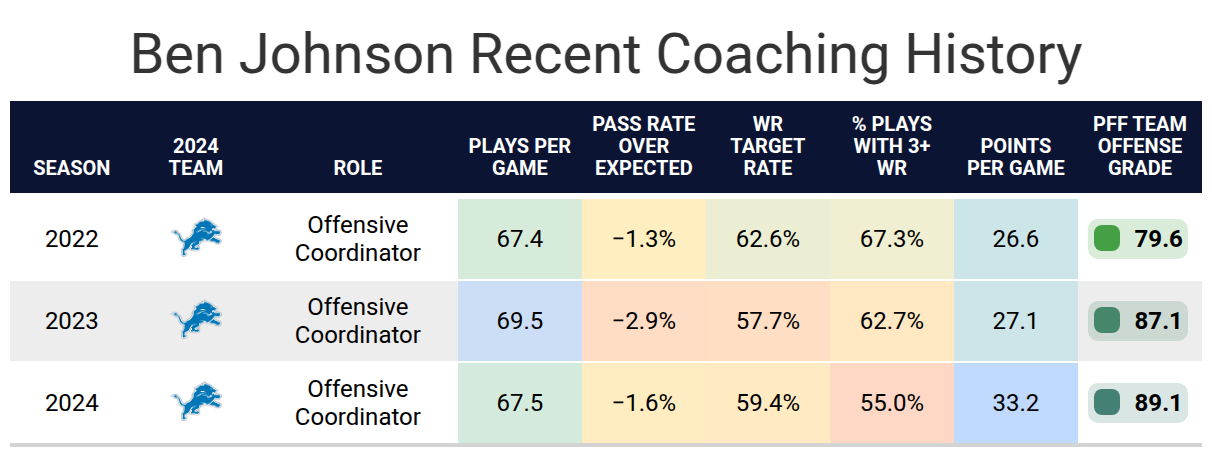
Burden was among the most talented wide receivers in the 2025 draft class but landed on a team with several other options in the passing game. If he can surpass others on the depth chart, he may be Ben Johnson’s Bears version of Amon-Ra St. Brown. If he doesn’t surpass others in the target pecking order, he might not be worth rostering in fantasy leagues by the end of the season.
